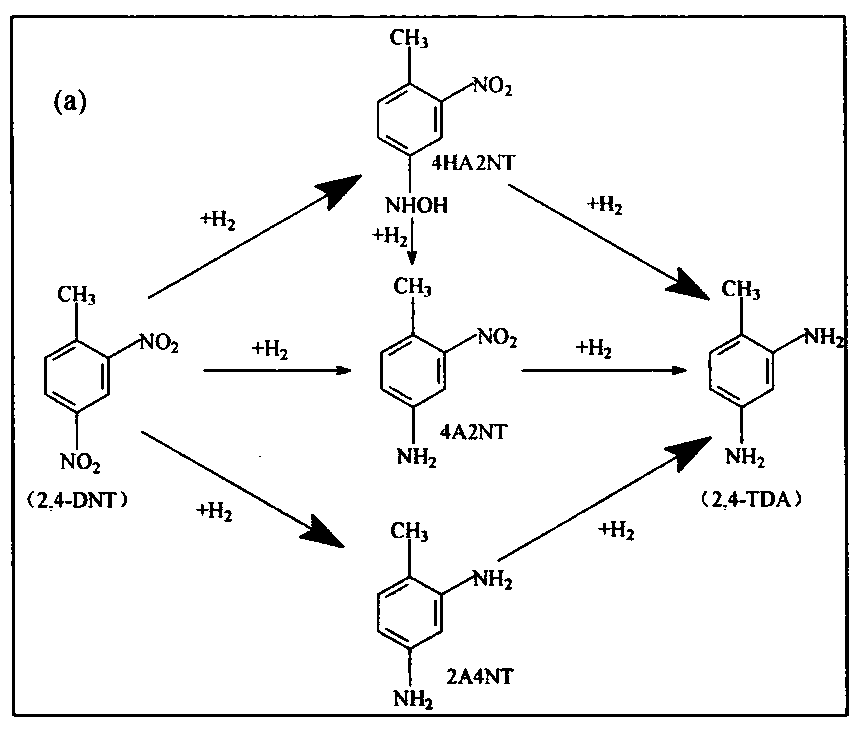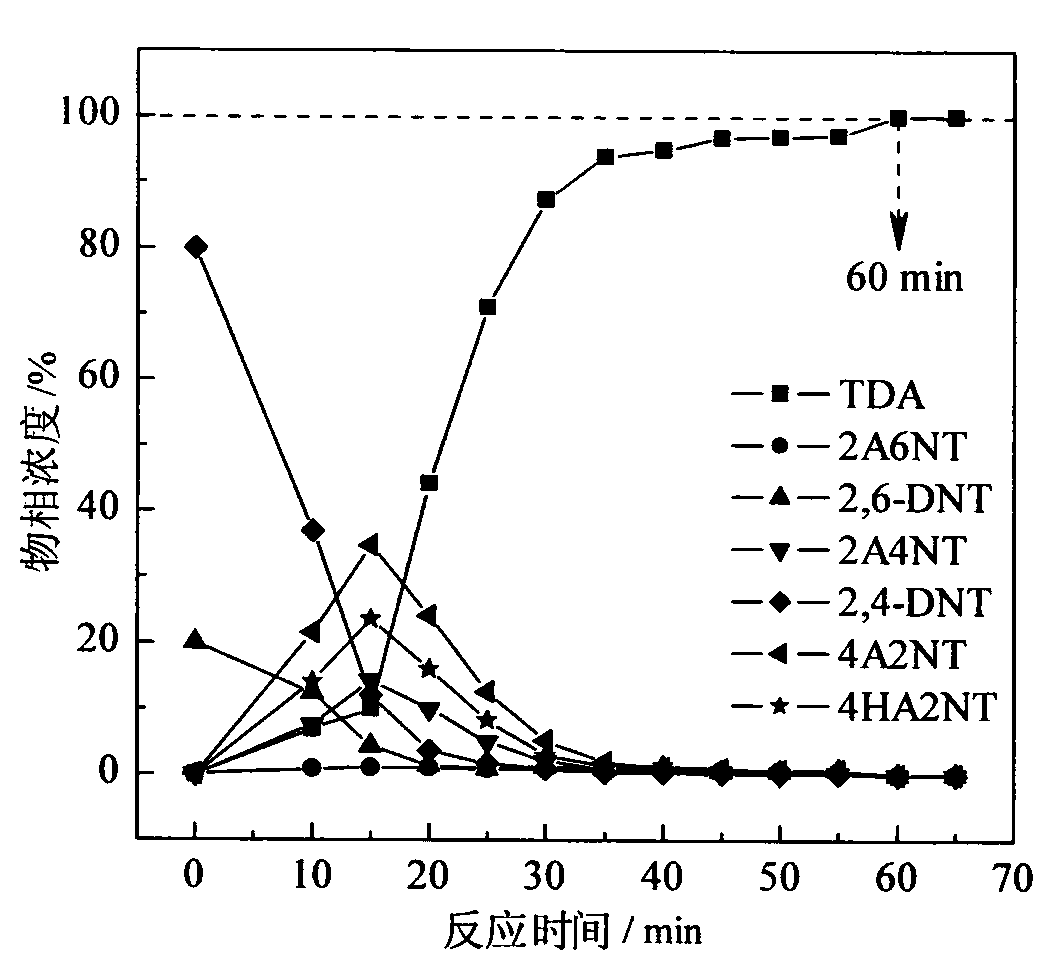Process for synthesis of toluenediamine by low pressure hydrogenation of dinitrotoluene, catalyst and preparation method of catalyst
A technology of dinitrotoluene and toluenediamine, which is used in physical/chemical process catalysts, Raney-type catalysts, preparation of amino compounds, etc., can solve the problems of external solvent, difficult reaction, and high reaction pressure.
- Summary
- Abstract
- Description
- Claims
- Application Information
AI Technical Summary
Problems solved by technology
Method used
Image
Examples
Embodiment 1
[0053] Mix 6 μm nickel powder, 5 μm aluminum powder and 8 μm additive metal Fe powder with a mass fraction of Ni55wt%—Al40wt%—Fe5wt%, and place it in a crucible with a funnel at the bottom and surrounded by SiC. / min speed heating to 1600 ℃ melting, after 0.8MPa Ar gasification and atomization to obtain alloy powder, the cooling rate is 1.0×10 6 K / s; mix the alloy powder and NaOH powder at a mass ratio of 1:1, add distilled water 3 times the volume of the alloy powder into the container dropwise at room temperature, and the dropping speed keeps the material wet evenly but does not form a liquid phase; After the dropwise addition, the suspension was sonicated at 20kHZ and 70°C for 40min, and then washed with distilled water to obtain a catalyst, which was stored in water for future use. The catalyst prepared by this embodiment is used for the specific operational route and reaction conditions of the hydrogenation of dinitrotoluene as follows:
[0054] a. the prepared Raney-Ni ...
Embodiment 2
[0059] Mix 5 μm nickel powder, 7 μm aluminum powder and 7 μm auxiliary metal powder with a mass fraction of Ni53wt%—Al43wt%—auxiliary 4wt%, and place it in a crucible with a funnel at the bottom and surrounded by SiC. Heating at the speed of ℃ / min to 1550 ℃ for melting, and then vaporized and atomized by 0.9MPa Ar to obtain alloy powder, the cooling rate is 1.2×10 6 K / s; mix the alloy powder and NaOH powder at a mass ratio of 1.1:1, add distilled water 4 times the volume of the alloy powder into the container dropwise at room temperature, and the dropping speed keeps the material wet evenly but does not form a liquid phase; After the dropwise addition, the suspension was ultrasonicated for 35 minutes at 30kHZ and 60°C, washed with distilled water to obtain the target catalyst, and stored in water for later use. The catalyst prepared by this embodiment is used for the specific operational route and reaction conditions of the hydrogenation of dinitrotoluene as follows:
[0060]...
Embodiment 3
[0065] Mix 4 μm nickel powder, 9 μm aluminum powder and 6 μm auxiliary metal powder with a mass fraction of Ni53wt%—Al45wt%—auxiliary 2wt%, and place it in a crucible with a funnel at the bottom and surrounded by SiC, and microwave at 60 The speed of ℃ / min is heated to 1500 ℃ for melting, and the alloy powder is obtained after gasification and atomization by 1.0MPa Ar, and the cooling rate is 1.3×10 6 K / s; mix the alloy powder and NaOH powder at a mass ratio of 1:2, add distilled water 5 times the volume of the alloy powder into the container dropwise at room temperature, and the dropping speed keeps the material wet evenly but does not form a liquid phase; After the dropwise addition, the suspension was ultrasonicated for 30 minutes at 50kHZ and 60°C, and then washed with distilled water to obtain a catalyst, which was stored in water for future use. The catalyst prepared by this embodiment is used for the specific operational route and reaction conditions of the hydrogenatio...
PUM
 Login to View More
Login to View More Abstract
Description
Claims
Application Information
 Login to View More
Login to View More - R&D
- Intellectual Property
- Life Sciences
- Materials
- Tech Scout
- Unparalleled Data Quality
- Higher Quality Content
- 60% Fewer Hallucinations
Browse by: Latest US Patents, China's latest patents, Technical Efficacy Thesaurus, Application Domain, Technology Topic, Popular Technical Reports.
© 2025 PatSnap. All rights reserved.Legal|Privacy policy|Modern Slavery Act Transparency Statement|Sitemap|About US| Contact US: help@patsnap.com



